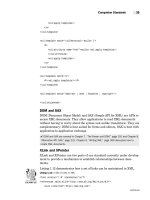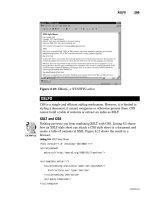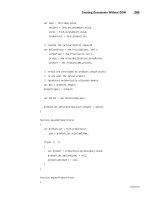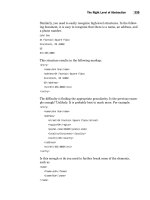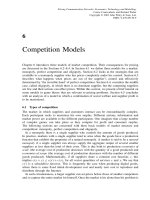Tài liệu XML by Example- P6 pptx
Bạn đang xem bản rút gọn của tài liệu. Xem và tải ngay bản đầy đủ của tài liệu tại đây (305.06 KB, 50 trang )
After the opening tag, the parser sees the content of the
name
element:
XML
Training
. It generates an event by passing the application the content as a
parameter.
The next event indicates the closing tag for the
name
element. The parser
has completely parsed the
name
element. It has fired five events so far:
three events for the
name
element, one event for the declaration, and one
for
product
opening tag.
The parser now moves to the first
price
element. It generates two events
for each
price
element: one event for the opening tag and one event for the
closing tag.
Even though the closing tag is reduced to the
/
character in the opening
tag, the parser generates an event for it. The parser passes the element’s
parameters to the application in the event for the opening tag.
There are four
price
elements, so the parser generates eight events as it
parses them. Finally, the parser meets
product
’s closing tag and it gener-
ates its last event.
As Figure 8.5 illustrates, taken together, the events describe the document
tree to the application. An opening tag event means “going one level down
in the tree,” whereas a closing tag element means “going one level up in the
tree.”
235
Why Another API?
Figure 8.5: How the parser builds the tree implicitly
An event-based interface is the most natural interface for a parser. Indeed,
the parser simply has to report what it sees.
Note that the parser passes enough information to build the document tree
of the XML documents but, unlike an object-based parser, it does not explic-
itly build the tree.
10 2429 CH08 11/12/99 1:09 PM Page 235
Please purchase PDF Split-Merge on www.verypdf.com to remove this watermark.
NOTE
If needed, the application can build a DOM tree from the events it receives from the
parser. In fact, several object-based parsers are built around an event-based parser.
Internally, they use an event-based parser and they create objects in response to the
events the parser generates.
Why Use Event-Based Interfaces?
Which type of interface do you use? An object-based or an event-based
interface? Unfortunately, there is no clean-cut answer to this question.
Neither of the two interfaces is intrinsically better; they serve different
needs.
The main reason people prefer event-based interfaces is efficiency. Event-
based interfaces are lower level than object-based interfaces. On the posi-
tive side, they give you more control over parsing and enable you to
optimize your application. On the downside, it means more work for you.
As already discussed, an event-based interface consumes fewer resources
than an object-based one, simply because it does not need to build the docu-
ment tree.
Furthermore, with an event-based interface, the application can start pro-
cessing the document as the parser is reading it. With an object-based
interface, the application must wait until the document has been com-
pletely read.
Therefore, event-based interfaces are particularly popular with applications
that process large files (which would take a lot of time to read and create a
document tree) and for servers (which process many documents simultane-
ously).
The major limitation of event-based interfaces is that it is not possible to
navigate through the document as you can with a DOM tree. Indeed, after
firing an event, the parser forgets about it. As you will see, the application
must explicitly buffer those events it is interested in. It might also have
more work in managing the state.
Of course, whether it uses an event-based or an object-based interface, the
parser does a lot of useful work: It reads the document, enforces the XML
syntax, and resolves entities. When using a validating parser, it might vali-
date the document against its DTD. So, there are many reasons to use a
parser.
236
Chapter 8: Alternative API: SAX
10 2429 CH08 11/12/99 1:09 PM Page 236
Please purchase PDF Split-Merge on www.verypdf.com to remove this watermark.
SAX: The Alternative API
By definition, the DOM recommendation does not apply to event-based
parsers. The members of the XML-DEV mailing list have developed a stan-
dard API for event-based parsers called SAX, short for the Simple API for
XML.
SAX is defined for the Java language. There is a version of SAX for Python
and Perl but currently none for JavaScript or C++. Furthermore, SAX is
not implemented in browsers; it is available only for standalone parsers.
Obviously, the examples in this chapter are written in Java. If you want to
learn how to write Java applications, refer to Appendix A, “Crash Course on
Java.”
SAX is edited by David Megginson and published at
www.megginson.com/
SAX
. Unlike DOM, SAX is not endorsed by an official standardization body
but it is widely used and is considered a de facto standard.
In particular, Sun has included SAX in ProjectX—an ongoing effort to add
an XML parser to the Java platform. ProjectX also supports DOM so the
parser offers both event-based and object-based interfaces. It is available
from
java.sun.com
.
The IBM parser, XML for Java (available from
www.alphaworks.ibm.com
),
and the DataChannel parser, XJParse (available from
www.datachannel.com
), are other parsers that support both the DOM and
SAX interfaces.
Microstar’s Ælfred (
www.microstar.com
) and James Clark’s XP
(
www.jclark.com
) support only the SAX interface.
Getting Started with SAX
Listing 8.2 is a Java application that finds the cheapest price from the list
of prices in Listing 8.1. The application prints the best price as well as the
name of the vendor.
Listing 8.2: Simple SAX Application
/*
* XML By Example, chapter 8: SAX
*/
package com.psol.xbe;
import org.xml.sax.*;
import org.xml.sax.helpers.ParserFactory;
237
SAX: The Alternative API
EXAMPLE
continues
10 2429 CH08 11/12/99 1:09 PM Page 237
Please purchase PDF Split-Merge on www.verypdf.com to remove this watermark.
/**
* SAX event handler to find the cheapest offering
* in a list of prices.
* @author
*/
public class Cheapest
extends HandlerBase
{
/*
* event handler
*/
/**
* properties we are collecting: cheapest price
*/
protected double min = Double.MAX_VALUE;
/**
* properties we are collecting: cheapest vendor
*/
protected String vendor = null;
/**
* startElement event: the price list is stored as price
* elements with price and vendor attributes
* @param name element’s name
* @param attributes element’s attributes
*/
public void startElement(String name,AttributeList attributes)
{
if(name.equals(“price”))
{
String attribute = attributes.getValue(“price”);
if(null != attribute)
{
238
Chapter 8: Alternative API: SAX
Listing 8.2: continued
10 2429 CH08 11/12/99 1:09 PM Page 238
Please purchase PDF Split-Merge on www.verypdf.com to remove this watermark.
double price = toDouble(attribute);
if(min > price)
{
min = price;
vendor = attributes.getValue(“vendor”);
}
}
}
}
/**
* helper method: turn a string in a double
* @param string number as a string
* @return the number as a double, or 0.0 if it cannot convert
* the number
*/
protected double toDouble(String string)
{
Double stringDouble = Double.valueOf(string);
if(null != stringDouble)
return stringDouble.doubleValue();
else
return 0.0;
}
/**
* property accessor: vendor name
* @return the vendor with the cheapest offer so far
*/
public String getVendor()
{
return vendor;
}
/**
* property accessor: best price
* @return the best price so far
239
SAX: The Alternative API
continues
10 2429 CH08 11/12/99 1:09 PM Page 239
Please purchase PDF Split-Merge on www.verypdf.com to remove this watermark.
*/
public double getMinimum()
{
return min;
}
/*
* main() method and properties
*/
/**
* the parser class (IBM’s XML for Java)
*/
protected static final String
PARSER_NAME = “com.ibm.xml.parsers.SAXParser”;
/**
* main() method
* decodes command-line parameters and invokes the parser
* @param args command-line argument
* @throw Exception catch-all for underlying exceptions
*/
public static void main(String[] args)
throws Exception
{
// command-line arguments
if(args.length < 1)
{
System.out.println(“java com.psol.xbe.CheapestCL
➥filename”);
return;
}
// creates the event handler
Cheapest cheapest = new Cheapest();
// creates the parser
240
Chapter 8: Alternative API: SAX
Listing 8.2: continued
10 2429 CH08 11/12/99 1:09 PM Page 240
Please purchase PDF Split-Merge on www.verypdf.com to remove this watermark.
Parser parser = ParserFactory.makeParser(PARSER_NAME);
parser.setDocumentHandler(cheapest);
// invokes the parser against the price list
parser.parse(args[0]);
// prints the results
System.out.println(“The cheapest offer is “ +
cheapest.getVendor() +
“ ($” + cheapest.getMinimum() + ‘)’);
}
}
Compiling the Example
To compile this application, you need a Java Development Kit (JDK) for
your platform. For this example, the Java Runtime is not enough. You can
download the JDK from
java.sun.com
. Furthermore, you have to download
the IBM parser, XML for Java, from
www.alphaworks.ibm.com
.
As always, I will post updates on
www.mcp.com
. So, if you have problems
downloading a component, visit
www.mcp.com
.
Save Listing 8.2 in a file called Cheapest.java. Go to the DOS prompt,
change to the directory where you saved Cheapest.java, and create an
empty directory called
classes
. The compile will place the Java program in
the classes directory. Finally, compile the Java source with
javac -classpath c:\xml4j\xml4j.jar -d classes Cheapest.java
This command assumes you have installed the IBM parser in
c:\xml4j
; you
might have to adapt the classpath if you installed the parser in a different
directory.
To run the application against the price list, issue the following command:
java -classpath c:\xml4j\xml4j.jar;classes
➥com.psol.xbe.Cheapest prices.xml
This command assumes that the XML price list from Listing 8.1 is in a file
called
prices.xml
.
CAUTION
The programs in this chapter do essentially no error checking. The programs minimize
errors; however, if you type parameters incorrectly, the programs can crash.
241
SAX: The Alternative API
10 2429 CH08 11/12/99 1:09 PM Page 241
Please purchase PDF Split-Merge on www.verypdf.com to remove this watermark.
Running this program against the price list in Listing 8.1 gives the result:
The cheapest offer is XMLi ($699.0)
Note that the classpath points to the parser and to the classes directory.
The fully qualified name of the file is
com.psol.xbe.Cheapest
.
CAUTION
This example won’t work unless you have installed a Java Development Kit.
If there is an error message similar to
“Exception in thread “main”
java.lang.NoClassDefFoundError”
, it means that either the classpath is incorrect
(be sure it points to the right directories) or that you typed an incorrect class name
(
com.psol.xbe.Cheapest
).
SAX Interfaces and Objects
Events in SAX are defined as methods attached to specific Java interfaces.
An application implements some of these methods and registers as an
event-handler with the parser.
Main SAX Events
SAX groups its events in a few interfaces:
•
DocumentHandler
defines events related to the document itself (such as
opening and closing tags). Most applications register for these events.
•
DTDHandler
defines events related to the DTD. Few applications regis-
ter for these events. Moreover, SAX does not define enough events to
completely report on the DTD (SAX-validating parsers read and use
the DTD but they cannot pass all the information to the application).
•
EntityResolver
defines events related to loading entities. Few applica-
tions register for these events. They are required to load entities from
special sources such as a database.
•
ErrorHandler
defines error events. Applications register for these
events if they need to report errors in a special way.
To simplify work, SAX provides a default implementation for all these
interfaces in the
HandlerBase
class. It is easier to extend
HandlerBase
and
override the methods that are relevant for the application rather than to
implement an interface directly.
Parser
To register event handlers and to start parsing, the application uses the
Parser
interface. To start parsing, the application calls
parse()
, a method of
Parser
:
parser.parse(args[0]);
242
Chapter 8: Alternative API: SAX
OUTPUT
EXAMPLE
10 2429 CH08 11/12/99 1:09 PM Page 242
Please purchase PDF Split-Merge on www.verypdf.com to remove this watermark.
Parser
defines the following methods:
•
parse()
starts parsing an XML document. There are two versions of
parse()
—one accepts a filename or a URL, the other an
InputSource
object (see section “InputSource”).
•
setDocumentHandler()
,
setDTDHandler()
,
setEntityResolver()
, and
setErrorHandler()
allow the application to register event handlers.
•
setLocale()
requests error messages in a specific Locale.
ParserFactory
ParserFactory
creates the parser object. It takes the class name for the
parser. For XML for Java, it is
com.ibm.xml.parsers.SAXParser
. To switch
to another parser, you can change one line and recompile:
protected static final String
PARSER_NAME = “com.ibm.xml.parsers.SAXParser”;
// ...
Parser parser = ParserFactory.makeParser(PARSER_NAME);
For more flexibility, the application can read the class name from the com-
mand line or from a configuration file. In this case, it is even possible to
change the parser without recompiling.
InputSource
InputSource
controls how the parser reads files, including XML documents
and entities.
In most cases, documents are loaded from the local file system or from a
URL. The default implementation of
InputSource
knows how to load them.
However, if an application has special needs, such as loading documents
from a database, it can override
InputSource
.
The
parse()
method is available in two versions—one takes a string, the
other an
InputSource
. The string version uses the default
InputSource
to
load the document from a file or a URL.
DocumentHandler
Listing 8.2 is simple because it needs to handle only the
startElement
mes-
sage. As the name implies, the message is sent when the parser sees the
opening tag of an element.
The event is defined by the
DocumentHandler
interface. The application cre-
ates a new class,
Cheapest
, which overrides the
startElement()
method.
The application registers
Cheapest
as an event handler with the parser.
// creates the event handler
243
SAX Interfaces and Objects
EXAMPLE
EXAMPLE
10 2429 CH08 11/12/99 1:09 PM Page 243
Please purchase PDF Split-Merge on www.verypdf.com to remove this watermark.
Cheapest cheapest = new Cheapest();
// ...
parser.setDocumentHandler(cheapest);
DocumentHandler
declares events related to the document. The following
events are available:
•
startDocument()
/
endDocument()
notify the application of the docu-
ment’s beginning or ending.
•
startElement()
/
endElement()
notify the application that an element
starts or ends (which corresponds to the opening and closing tags
of the element). Attributes are passed as an
AttributeList
; see
the section “AttributeList” that follows. Empty elements (
<img
href=”logo.gif”/>
) generate both
startElement
and
endElement
events even though there is only one tag.
•
characters()
/
ignorableWhitespace()
notify the application when the
parser finds content (text) in an element. The parser can break a
piece of text in several events or pass it all at once as it sees fit.
However, one event is always attached to a single element. The
ignorableWhitespace
event is used for ignorable spaces as defined
by the XML specs.
•
processingInstruction()
notifies the application of processing instruc-
tions.
•
setDocumentLocator()
passes a
Locator
object to the application; see
the section “Locator” that follows. Note that the SAX parser is not
required to supply a
Locator
, but if it does, it must fire this event
before any other event.
AttributeList
In the event, the application receives the element name and the list of
attributes in an
AttributeList
.
In this example, the application waits until a
price
element is found. It
then extracts the vendor name and the price from the list of attributes.
Armed with this information, finding the cheapest product requires a
simple comparison:
public void startElement(String name,AttributeList attributes)
{
if(name.equals(“price”))
{
String attribute = attributes.getValue(“price”);
244
Chapter 8: Alternative API: SAX
EXAMPLE
10 2429 CH08 11/12/99 1:09 PM Page 244
Please purchase PDF Split-Merge on www.verypdf.com to remove this watermark.
if(null != attribute)
{
double price = toDouble(attribute);
if(min > price)
{
min = price;
vendor = attributes.getValue(“vendor”);
}
}
}
}
The parser uses
AttributeList
in the
startElement
event. As the name
implies, an
AttributeList
encapsulates a list of attributes. It defines the
following methods:
•
getLength()
returns the length of the attribute list.
•
getName(i)
returns the name of the ith attribute (where i is an integer).
•
getType(i)
/
getType(name)
return the type of the ith attribute or the
type of the attribute whose name is given. The first method accepts an
integer, the second a string. The type is a string, as used in the DTD:
“CDATA”
,
“ID”
,
“IDREF”
,
“IDREFS”
,
“NMTOKEN”
,
“NMTOKENS”
,
“ENTITY”
,
“ENTITIES”
, or
“NOTATION”
.
•
getValue(i)
/
getValue(name)
return the value of the ith attribute or
the value of an attribute whose name is given.
Locator
A
Locator
enables the application to retrieve line and column positions. The
parser may provide a
Locator
object. If the application is interested in line
information, it must retain the reference to the
Locator
.
Locator
defines the following methods:
•
getColumnNumber()
returns the column where the current event ends.
In an
endElement
event, it would return the last column of the end tag.
•
getLineNumber()
returns the line where the current event ends. In an
endElement
event, it would return the last line of the end tag.
•
getPublicId()
returns the public identifier for the current document
event.
•
getSystemId()
returns the system identifier for the current document
event.
245
SAX Interfaces and Objects
10 2429 CH08 11/12/99 1:09 PM Page 245
Please purchase PDF Split-Merge on www.verypdf.com to remove this watermark.
DTDHandler
DTDHandler
declares two events related to parsing the DTD:
•
notationDecl()
notifies the application that a notation has been
declared.
•
unparsedEntityDecl()
notifies the application that an unparsed entity
declaration has been found.
EntityResolver
✔ The EntityResolver interface defines only one event, resolveEntity(). The
method returns an InputSource, which was introduced in the section “InputSource”
on page 243.
Few applications need to implement
EntityResolver
because the SAX
parser can resolve filenames and most URLs already.
ErrorHandler
The
ErrorHandler
interface defines several events in case of errors.
Applications that handle these events can provide custom error processing.
After a custom error handler is installed, the parser doesn’t throw excep-
tions anymore. Throwing exceptions is the responsibility of the event
handlers.
There are three methods in this interface that correspond to three levels or
gravity of errors:
•
warning()
signals problems that are not errors as defined by the XML
specification. For example, some parsers issue a warning when there
is no XML declaration. It is not an error (because the declaration is
optional), but it is worth noting.
•
error()
signals errors as defined by the XML specification.
•
fatalError()
signals fatal errors, as defined by the XML specification.
SAXException
Most methods defined by the SAX standard can throw a
SAXException
.
A
SAXException
signals an error while parsing the XML document.
The error can either be a parsing error or an error in an event handler. To
report errors from the event handler, it is possible to wrap exceptions in
SAXException
.
246
Chapter 8: Alternative API: SAX
10 2429 CH08 11/12/99 1:09 PM Page 246
Please purchase PDF Split-Merge on www.verypdf.com to remove this watermark.
Suppose an event handler catches an
IndexOutOfBoundsException
while
processing the
startElement
event. The event handler wraps the
IndexOutOfBoundsException
in a
SAXException
:
public void startElement(String name,AttributeList attributes)
{
try
{
// the code may throw an IndexOutOfBoundsException
}
catch(IndexOutOfBounds e)
{
throw new SAXException;
}
}
The
SAXException
flows all the way up to the
parse()
method where it is
caught and interpreted:
try
{
parser.parse(uri);
}
catch(SAXException e)
{
Exception x = e.getException();
if(null != x)
if(x instanceof IndexOutOfBoundsException)
// process the IndexOutOfBoundsException
}
Maintaining the State
Listing 8.1 on page 234 is convenient for a SAX parser because the informa-
tion is stored as attributes of price elements. The application has to register
only for
elementStart
.
Listing 8.3 is more complex because the information is scattered across sev-
eral elements. Specifically, vendors have different prices depending on the
urgency of the delivery. Therefore, finding the lowest price is more difficult.
If the user waits longer, he or she might get a better price. Figure 8.6 illus-
trates the structure of the document.
247
Maintaining the State
EXAMPLE
EXAMPLE
10 2429 CH08 11/12/99 1:09 PM Page 247
Please purchase PDF Split-Merge on www.verypdf.com to remove this watermark.
Figure 8.6: Price list structure
Listing 8.3: Price List with Delivery Information
<?xml version=”1.0”?>
<product>
<name>XML Training</name>
<vendor>
<name>Playfield Training</name>
<price delivery=”5”>999.00</price>
<price delivery=”15”>899.00</price>
</vendor>
<vendor>
<name>XMLi</name>
<price delivery=”3”>2999.00</price>
<price delivery=”30”>1499.00</price>
<price delivery=”45”>699.00</price>
</vendor>
<vendor>
<name>WriteIT</name>
<price delivery=”5”>799.00</price>
<price delivery=”15”>899.00</price>
</vendor>
<vendor>
<name>Emailaholic</name>
<price delivery=”2”>1999.00</price>
</vendor>
</product>
To find the best deal, the application must collect information from several
elements. However, the parser may generate up to three events for each
element (start, character, and end). The application must somehow relate
events and elements by managing the state.
✔ See the section “Managing the State” in Chapter 7 for a discussion of state (page 207).
The example in this section achieves the same result but for a SAX parser.
248
Chapter 8: Alternative API: SAX
10 2429 CH08 11/12/99 1:09 PM Page 248
Please purchase PDF Split-Merge on www.verypdf.com to remove this watermark.
Listing 8.4 is a new Java application that looks for the best deal in the
price list. When looking for the best deal, it takes the urgency in considera-
tion. Indeed, the cheapest vendor (XMLi) is also the slowest one to deliver.
On the other hand, Emailaholic is expensive but it delivers in two days.
Listing 8.4: Improved Best Deal Looker
/*
* XML By Example, chapter 8: SAX
*/
package com.psol.xbe;
import java.util.*;
import org.xml.sax.*;
import org.xml.sax.helpers.ParserFactory;
/**
* Starting point class: initializes the parser, creates the
* various objects, etc.
* @author
*/
public class BestDeal
{
/**
* the parser class (IBM’s XML for Java)
*/
private static final String
PARSER_NAME = “com.ibm.xml.parsers.SAXParser”;
/**
* main() method
* decodes command-line parameters and invokes the parser
* @param args command-line argument
* @throw Exception catch-all for underlying exceptions
*/
public static void main(String[] args)
throws Exception
{
249
Maintaining the State
continues
10 2429 CH08 11/12/99 1:09 PM Page 249
Please purchase PDF Split-Merge on www.verypdf.com to remove this watermark.
if(args.length < 2)
{
System.out.println(“java com.psol.xbe.BestDeal filename delivery”);
return;
}
ComparingMachine comparingMachine =
new ComparingMachine(Integer.parseInt(args[1]));
SAX2Internal sax2Internal =
new SAX2Internal(comparingMachine);
try
{
Parser parser = ParserFactory.makeParser(PARSER_NAME);
parser.setDocumentHandler(sax2Internal);
parser.parse(args[0]);
}
catch(SAXException e)
{
Exception x = e.getException();
if(null != x)
throw x;
else
throw e;
}
System.out.println(“The best deal is proposed by “ +
comparingMachine.getVendor());
System.out.println(“a “ +
comparingMachine.getProductName() +
“ at “ + comparingMachine.getPrice() +
“ delivered in “ +
comparingMachine.getDelivery() +
“ days”);
}
}
250
Chapter 8: Alternative API: SAX
Listing 8.4: continued
10 2429 CH08 11/12/99 1:09 PM Page 250
Please purchase PDF Split-Merge on www.verypdf.com to remove this watermark.
/**
* This class receives events from the SAX2Internal adapter
* and does the comparison required.
* This class holds the “business logic.”
*/
class ComparingMachine
{
/**
* properties we are collecting: best price
*/
protected double bestPrice = Double.MAX_VALUE;
/**
* properties we are collecting: delivery time
*/
protected int proposedDelivery = Integer.MAX_VALUE;
/**
* properties we are collecting: product and vendor names
*/
protected String productName = null,
vendorName = null;
/**
* target delivery value (we refuse elements above this target)
*/
protected int targetDelivery;
/**
* creates a ComparingMachine
* @param td the target for delivery
*/
public ComparingMachine(int td)
{
targetDelivery = td;
}
251
Maintaining the State
continues
10 2429 CH08 11/12/99 1:09 PM Page 251
Please purchase PDF Split-Merge on www.verypdf.com to remove this watermark.
/**
* called by SAX2Internal when it has found the product name
* @param name the product name
*/
public void setProductName(String name)
{
productName = name;
}
/**
* called by SAX2Internal when it has found a price
* @param vendor vendor’s name
* @param price price proposal
* @param delivery delivery time proposal
*/
public void compare(String vendor,double price,int delivery)
{
if(delivery <= targetDelivery)
{
if(bestPrice > price)
{
bestPrice = price;
vendorName = vendor;
proposedDelivery = delivery;
}
}
}
/**
* property accessor: vendor’s name
* @return the vendor with the cheapest offer so far
*/
public String getVendor()
{
return vendorName;
}
252
Chapter 8: Alternative API: SAX
Listing 8.4: continued
10 2429 CH08 11/12/99 1:09 PM Page 252
Please purchase PDF Split-Merge on www.verypdf.com to remove this watermark.
/**
* property accessor: best price
* @return the best price so far
*/
public double getPrice()
{
return bestPrice;
}
/**
* property accessor: proposed delivery
* @return the proposed delivery time
*/
public int getDelivery()
{
return proposedDelivery;
}
/**
* property accessor: product name
* @return the product name
*/
public String getProductName()
{
return productName;
}
}
/**
* SAX event handler to adapt from the SAX interface to
* whatever the application uses internally.
*/
class SAX2Internal
extends HandlerBase
{
/**
253
Maintaining the State
continues
10 2429 CH08 11/12/99 1:09 PM Page 253
Please purchase PDF Split-Merge on www.verypdf.com to remove this watermark.
* state constants
*/
final protected int START = 0,
PRODUCT = 1,
PRODUCT_NAME = 2,
VENDOR = 3,
VENDOR_NAME = 4,
VENDOR_PRICE = 5;
/**
* the current state
*/
protected int state = START;
/**
* current leaf element and current vendor
*/
protected LeafElement currentElement = null,
currentVendor = null;
/**
* BestDeal object this event handler interfaces with
*/
protected ComparingMachine comparingMachine;
/**
* creates a SAX2Internal
* @param cm the ComparingMachine to interface with
*/
public SAX2Internal(ComparingMachine cm)
{
comparingMachine = cm;
}
/**
* startElement event
* @param name element’s name
254
Chapter 8: Alternative API: SAX
Listing 8.4: continued
10 2429 CH08 11/12/99 1:09 PM Page 254
Please purchase PDF Split-Merge on www.verypdf.com to remove this watermark.


